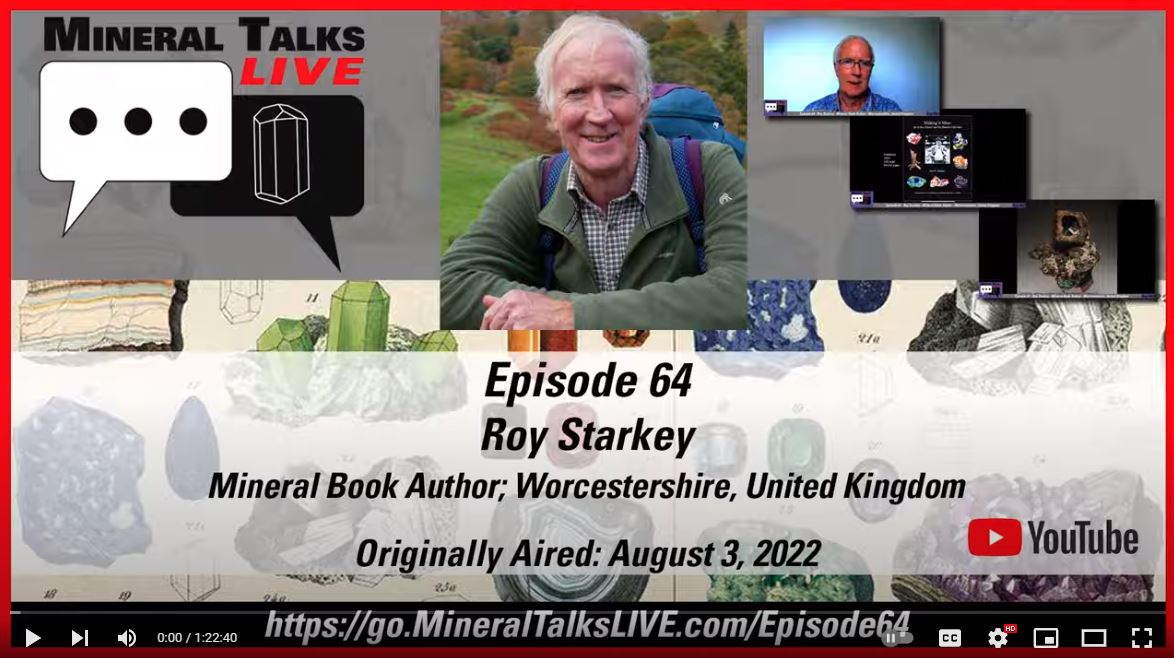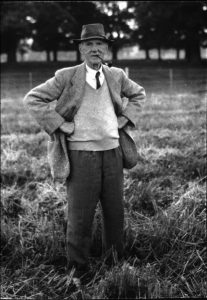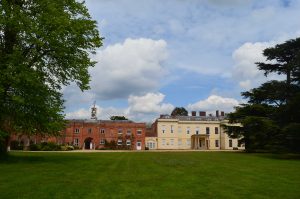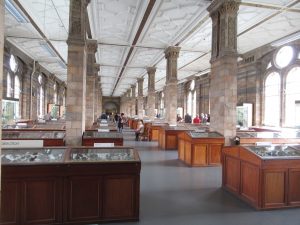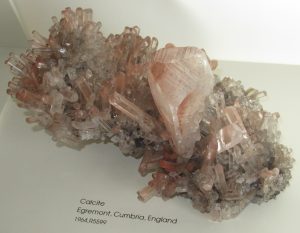STOP PRESS: You can read a review of the book published in Mineralogical Magazine here Making it Mine – review Mineralogical Magazine (2023)
An online review in Geoscientist is available here
You can read a recent review of the book published in The Mineralogical Record here Making it Mine – review Min.Rec. vol.53 no.5 (Review reproduced by kind permission of The Mineralogical Record).
You can now order a copy via the book orders page here
Sir Arthur Edward Ian Montague Russell (1878 – 1964) 6th Baronet, of Swallowfield Park, Reading, Berkshire, was perhaps the greatest British mineral collector of the twentieth century.
His superb collection of British minerals was bequeathed to the Natural History Museum in London in 1964.
His tenacity and dogged determination in seeking out the very best specimens for his collection was comparable to the reputation of the Canadian Mounties in always “getting their man”.
You can learn more about Sir Arthur Russell in an online document that I prepared for the fiftieth anniversary of his death in February 2014 here
Updated 7 January 2022
In spite of many difficulties presented by the Covid-19 pandemic the project is still on track, with typesetting and layout commencing on Monday 10 January.
My current expectation is that I should be able to get the book published during the first half of 2022 if all goes well.
The book will be the same page size/format as my other two books Crystal Mountains Minerals of the Cairngorms and Minerals of the English Midlands, matching the trail-blazing Minerals of Cornwall and Devon by Peter Embrey and Bob Symes, published in 1987, and followed by volumes from various authors and institutions over the intervening 35 years (yes it REALLY is that long ago!).
Making it Mine explores the fascinating story of Sir Arthur Russell 6th Baronet as he pursued his quest to build the finest collection of British minerals ever assembled. Running to more than 400 large format pages and lavishly illustrated with more than 750 photographs and diagrams, including more than 400 previously unpublished images of specimens from Sir Arthur’s collection, the book delves into his family history, the background to his passion for mineralogy and his single-minded determination to secure the very best specimens for his collection. The stories and people behind the specimens are woven into a compelling narrative together with sketches and anecdotes concerning the many colleagues and contacts that assisted him along the way.
The book will appeal to all those interested in British mineralogy, to mineral collectors and dealers, to historians of mineralogy, museum curators, university researchers and to anyone who is simply interested in the treasures of the natural world. This is neither a coffee table book nor a biography, but rather a blend of the two that takes the reader on an absorbing journey through the last 200 years of mineral collecting. If you have any ex-Sir Arthur Russell specimens in your collection you really won’t want to miss this book!
In Victorian times it was not uncommon for authors to seek advance subscriptions to help defray the cost of publication – see for example the subscribers to Observations on the West of England Mining Region by J. H. Collins (1921).
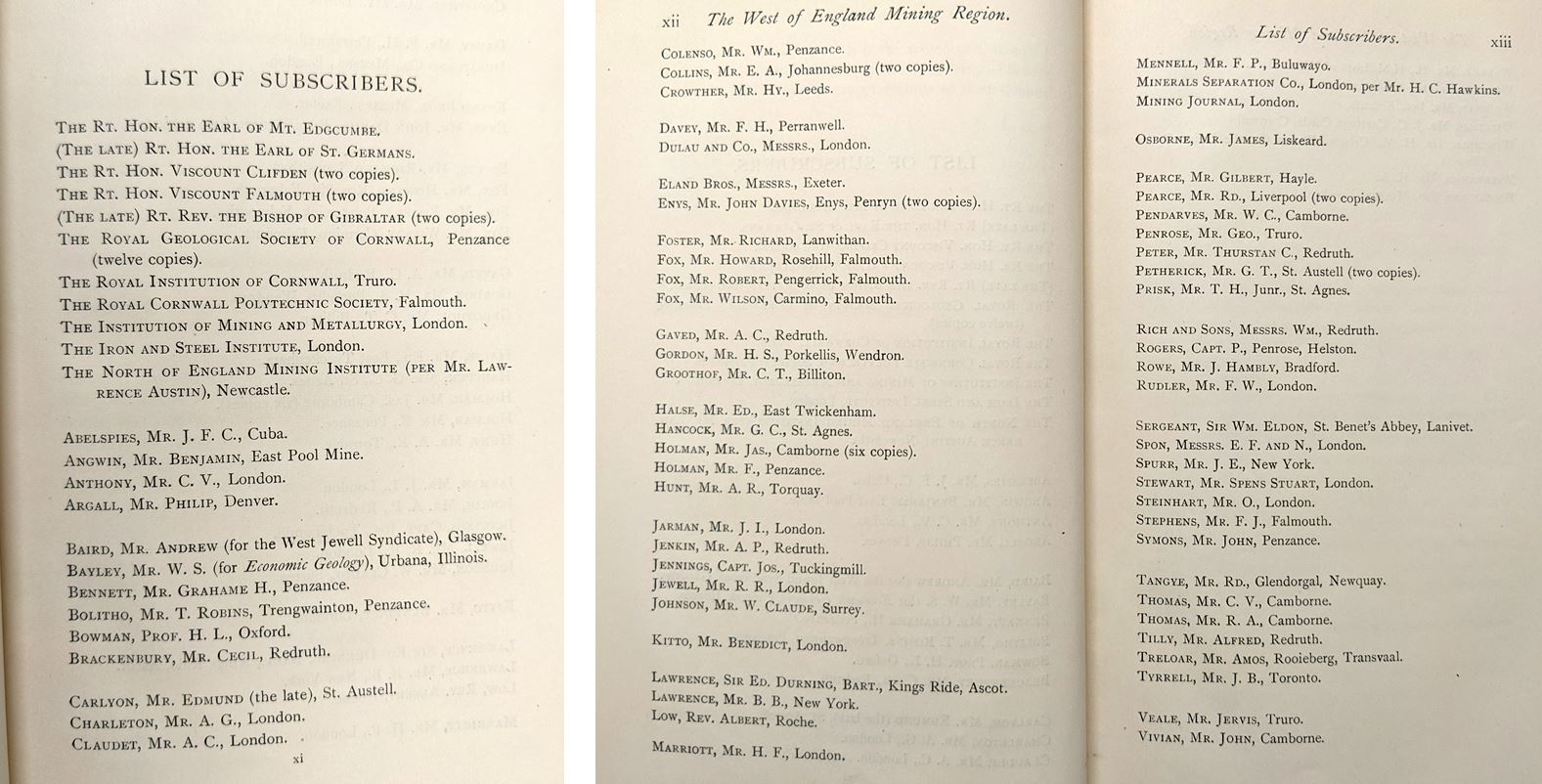
To assist me in determining what print run to go for I am proposing to offer the opportunity for advance subscribers to have their names similarly recorded for posterity as supporters of the Russell book.
UPDATE 24 February – please note that the subscriber offer is now closed. Thank you to the 180 people who signed-up.
I will post periodic updates here so do please check back regularly.
If you would like to be notified when the book is available please send me a message via the contact form.
Meanwhile, please tell your friends, and if you are active on social media or a member of a mineral group or club, please spread the word!
Thank you for your interest.
Updated 15 January 2022
Well, it has been quite an eventful and stressful first week, battling with the new updated version of Quark (the program my typesetter uses for the layout), and getting ourselves organised into a regular routine (which includes an early start for me, scraping the ice off the car before the 40 minute daily commute to Evesham).
For those who are not familiar with desktop publishing and printing I will briefly explain the process.
The final ‘clean’ WORD file of the manuscript has to be imported into a typesetting package in order to create a file format that the printing industry can use to manufacture the offset litho plates for printing.
This is a somewhat tedious and exacting process and has more similarities with building a house or an engineering project than it does with typing or word processing.
The first step is to take all the hi-res image files in RGB (the format that your PC uses to display images) and import them to Photoshop for conversion to CMYK format used for the four colour printing process. Work on this has been going on for several weeks prior to Xmas to create folders of CMYK images for each chapter. At this stage the files are left full-size because we do not yet know exactly what dimensions the images will be on the final page layout. This step follows later.
Next the template specifying the page size, margins, font to be used, single / double column etc. has to be created and saved in Quark.
Then, gradually, a little at a time, text is imported into Quark and essentially pasted into text boxes and positioned on the page in the desired layout. Figure captions and footnotes have to be cut out of the main text and set into their own text boxes, the font changed and re-sized and the box positioned on the page.
A first draft page layout is then arrived at and any images imported into image boxes and positioned. Images may positioned within the margins of the page or run off to the left or right hand edge (known as a bleed), when a 3 mm overlap is required to ensure that when the printed pages are guillotined to finished size the ink runs to the cut edge.
At this point the text generally requires moving around to obtain the optimum layout. Once a ‘final’ arrangement is settled upon the page can be viewed ‘zoomed out’ and inspected for text ‘defects’ such as ‘rivers of white’ – spaces running down the page between words, ‘widows and orphans’ – lone letters or words the the end or beginning of lines and so on.
Such issues are addressed by forcing words over onto the next or previous line of text, and in some cases by adjusting the kerning (spacing between the characters), and in extremis by shrinking the text by perhaps 1% or 2% which is not discernible to the naked eye.
Next the precise dimensions of each image are measured on screen and the original h-res image is re-opened in Photoshop, cropped to the required dimensions and then re-saved at a resolution of 300 dpi (at page width) the resolution at which the printing process operates. The re-sized image is then embedded into the Quark file.
Each page has its own idiosyncrasies and problems and it is not uncommon for significant mental effort and trial and error to be required in order to arrive at a satisfactory final result.
Once the page layout is finalised, the page is ‘locked’ so that nothing can move around and a new text box is opened on the following page. The process starts again.
Prior to commencing work on the layout a detailed page plan is prepared so that a reasonably accurate prediction of the number of pages in each chapter, and hence the overall page count of the book can be generated. The goal is to produce a finished result that is an integral multiple of 16 (because the printing process prints 16 pages at a time and the large sheet of paper is then folded and cut to form a 16 page section of the book). We’ll talk about printing and binding later in the project.
As typesetting progresses a close eye has to be kept on the number of pages vs the plan and image sizes adjusted accordingly to make sure we are going to hit the ‘landing spot’ – a nerve-wracking business! More on this another time.
At the end of each day we generate a PDF file of the work completed and I take this away for checking during the evening so that corrections can be made as necessary the following day (no rest for the wicked!).
Then it is time to pack-up all my papers, the laptop, lunchbox etc. and get back in the car for the dark (and this week, foggy and icy) drive home. Thursday evening was particularly clear as I came over the hill before descending into the fog of the valley (see photo at the top of this post).
So, at the end of four days of intense activity this week we have 65 type-set pages. We’ve chomped our way through 190,000 characters (37,000 words) and inserted 91 images. So, there are ‘only’ another 127,000 words and 659 images to go! (Plus, of course, the index – more on that another time too!).
The next step is to double-check all of this for any errors, omissions, typesetting problems like spacing around hyphens, upper/lower-case formatting, superscripts and sub-scripts and of course, simple spelling and typographical errors that may have crept in during all the re-working of the text. In parallel with my own checks the PDF file is sent for checking by my two per-reviewers – it really is vital to get other people to read the text. Different people see different things. It is very much a team-effort.
On Monday we’ll make any further corrections required and the whole thing starts again.
Meanwhile I’m still working on finishing off a couple of appendices and starting to ramp-up some advance publicity for the book.
If any of you are lucky enough to be going to the Tucson Show, please spread the word and give the project a helping hand.
Updated 22 January 2022
Well, we’ve now completed the second week of the layout and are making steady progress.
After seven days of focused effort (and many hours of checking and making adjustments / corrections) we now have 121 typeset pages and it is looking good!
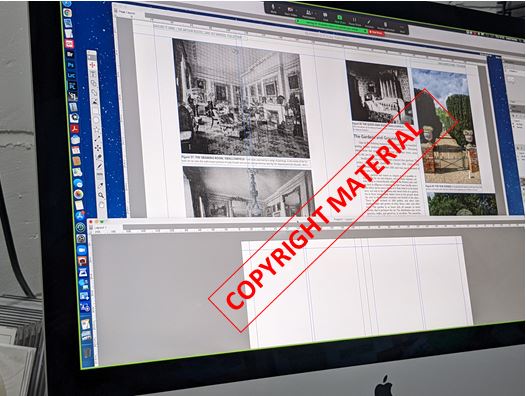
The first part of the book deals with the history of the Russell family and how they came to purchase Swallowfield Park. The next few chapters deal with various aspects of Sir Arthur Russell’s life and how he went about building the collection.
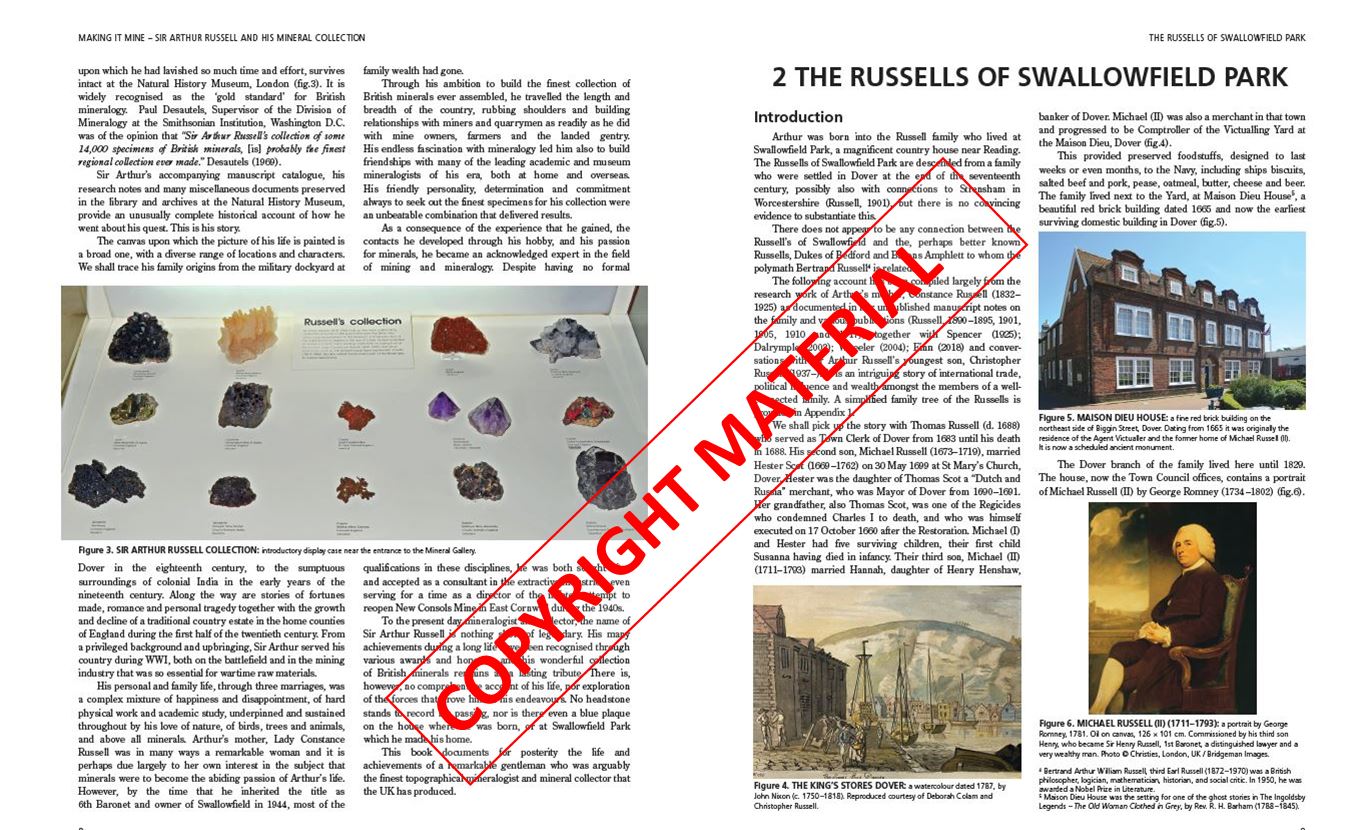
Next week will be largely taken up with a major chapter on the old collections which Sir Arthur acquired with plenty of nice mineral ‘eye-candy’ and lots of interesting historical detail – projected to be about 90 pages.
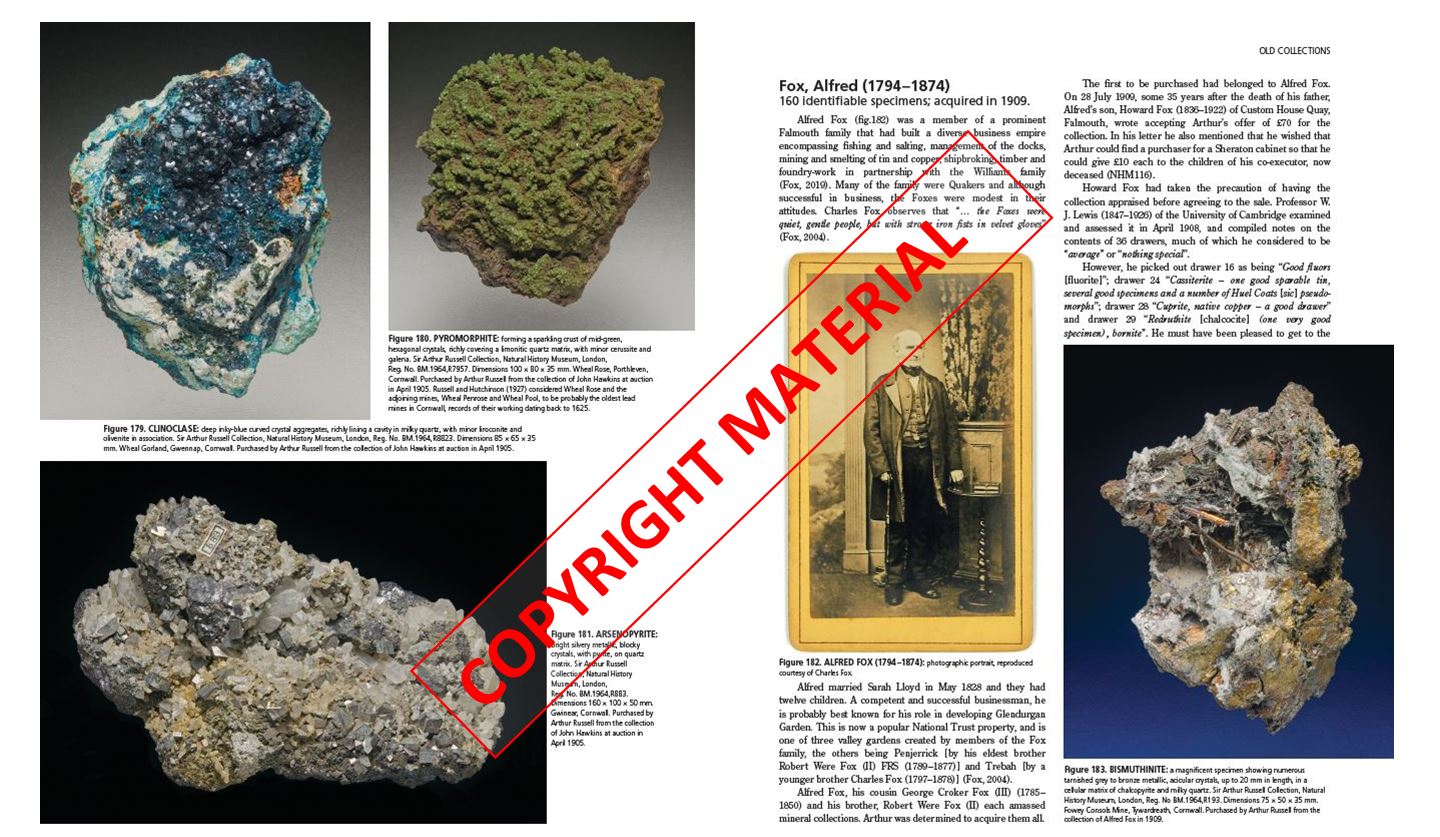
So far we’ve processed about 69,000 words out of a total 204,000 words and inserted 183 figures out of a total of 750, so we are approaching about 30% of the total based on my best estimates. My expectation before we started was that the finished total page count (including 6 un-numbered pages at the start) would be 448 pages, with a goal to reduce this to 432 if possible (the same as Minerals of the English Midlands).
The printing process works on a multiple of 16 because of the way the large sheets are folded and cut to form each section of the book block.
Currently it looks as if 432 pages may be achievable, but we won’t really be able to re-assess that properly until we are through Chapter 11 and beyond the half-way point – hopefully by the end of next week.
Updated 15 January 2022
It was another busy but successful week, with a further 45,000 words added to the typeset pages, and 88 additional images.
The running total so far is now 114,000 words (more than half a million characters)processed and 363 images and figures embedded into the document, making 209 typeset pages. We are now approaching the half-way point and the page count budget is looking broadly under control.
We’ll be watching closely as we pass the ‘tipping point’, in the run down to completion and my current forecast is still to be able to ‘land’ somewhere in the target range of 432 to 448 pages (see chart below).
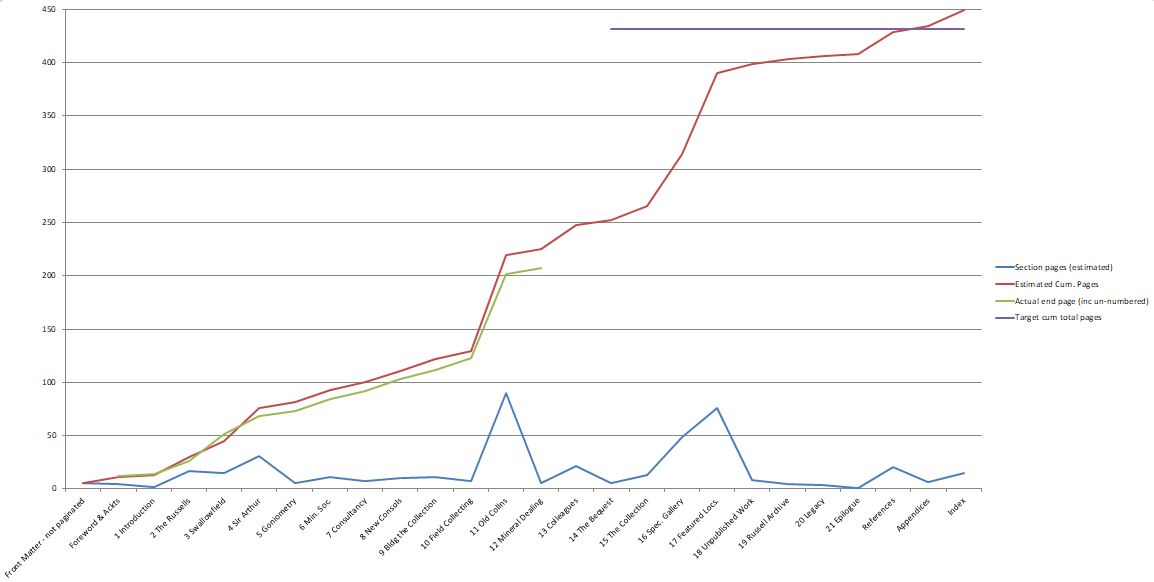
The blue line at the bottom of the chart is the projected page count for each individual chapter – the large ones are chapters 11, 16 and 17. The green line shows the actual cumulative typeset page count, compared to the red line which is the original estimate of cumulative page count. The purple horizontal line at the top right of the chart marks 448 pages, the absolute maximum (the goal is to come in at 432 pages!).
We have just completed one of the largest chapters, on old collections which is very image rich, and there are two further chapters which are picture-heavy – the specimen gallery and ‘featured localities’.
In parallel with typesetting I have now made a start on ‘tagging’ words in the WORD master for index generation. This will enable generation of a list of page occurrences for all selected terms and words – mineral names, places, people etc., in preparation for the tortuous and time-consuming manipulation that will eventually generate the final index for the book.
Finally, here’s a sneak peek at a few spreads from the Old Collections chapter.
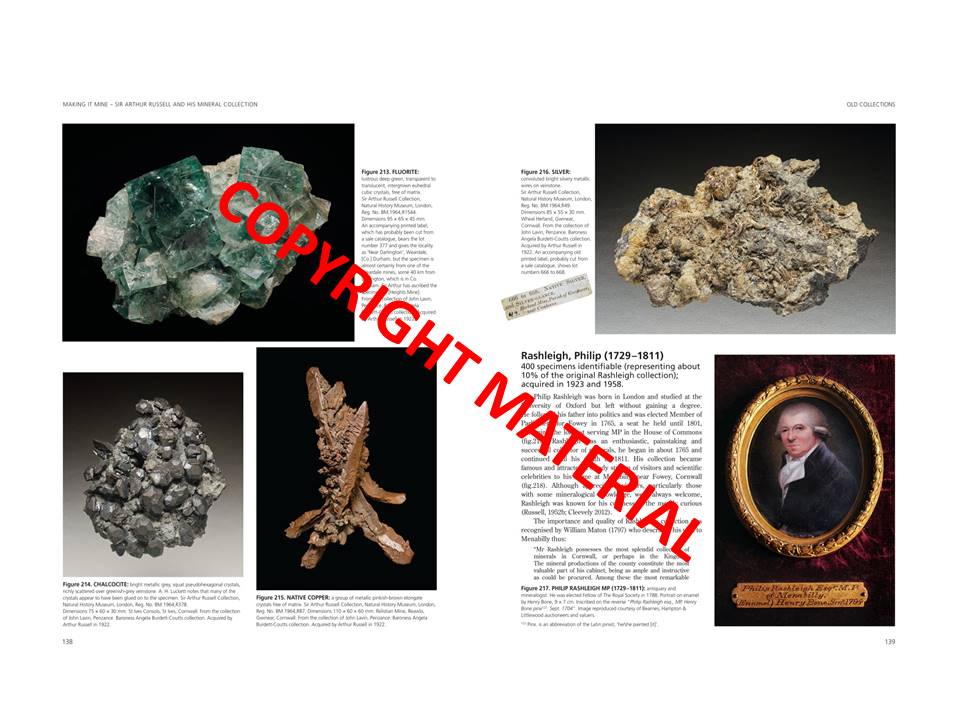
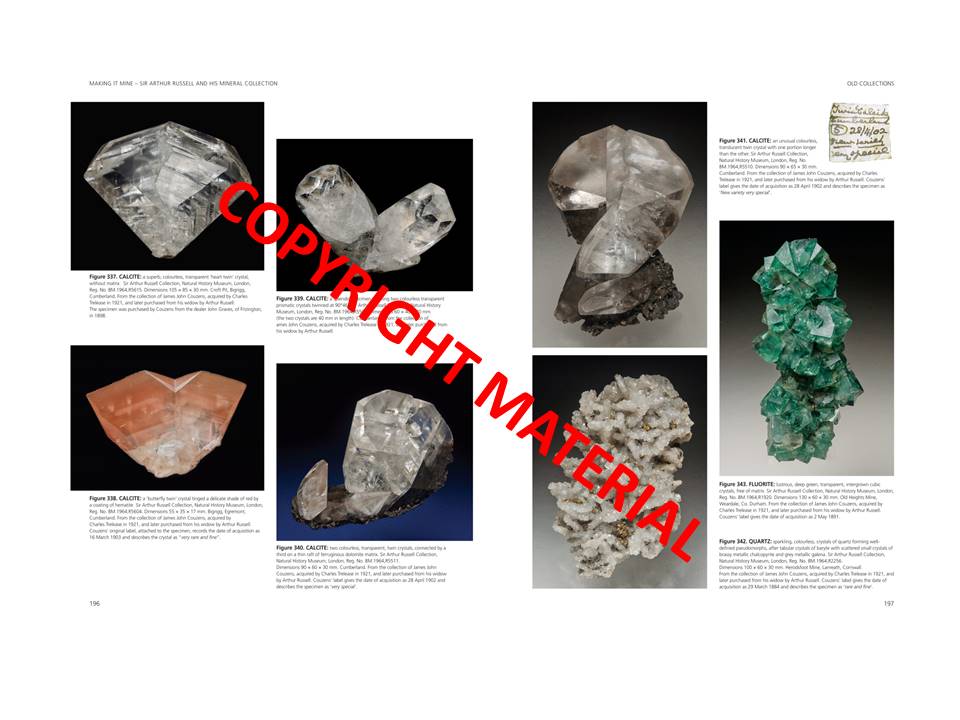
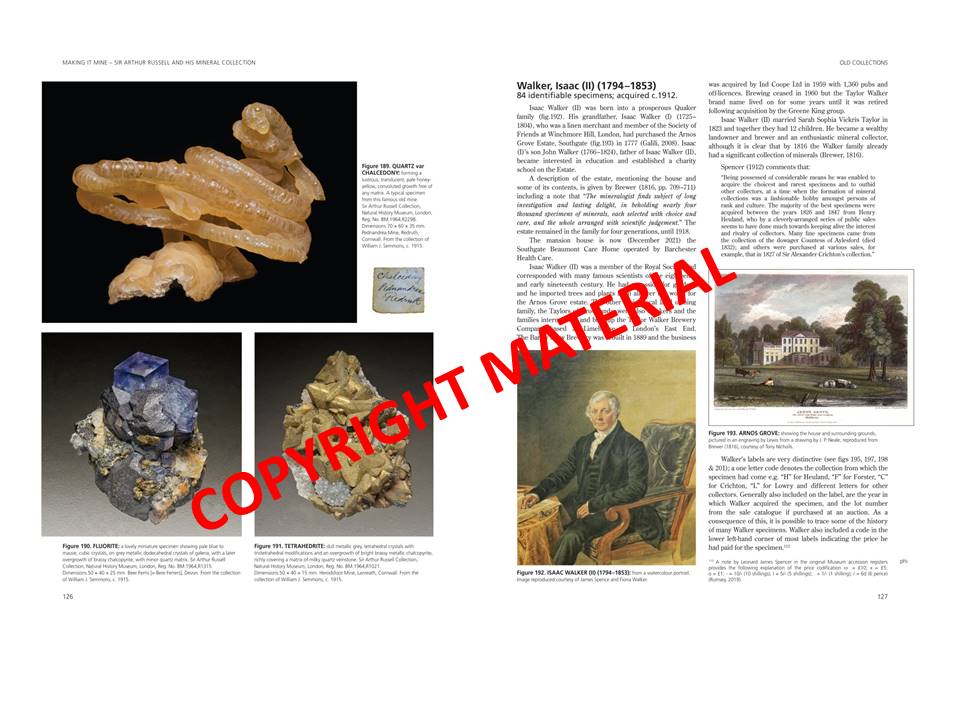
Updated 16 February 2022
Well it has been a crazily busy few weeks. We’ve made great progress with typesetting and the layout looks fantastic (yes, I am biased!).
It took a lot of careful planning and advance decision making on image sizes and positioning but we are on target for 432 pages which is great news.
The layout of the core text is now completed and the key remaining block of text is the references section (about 18 pages of detailed complicated formatting – oh joy!).
My focus has now switched to the index. The methodology for this is broadly as follows:-
First a second version of the WORD manuscript is generated to match the page layout of the final typeset book – i.e. the first and last words on every page must be the same, and the images must match. This is achieved fairly crudely by shrinking the text in WORD to fit the page (can be a bit of a squeeze) and forcing a page break at the end of every page. Next all words of possible interest for inclusion are tagged using the indexing tool under the REVIEW tab in word. This enable s the generation of a simple listing of every occurrence of, for example, calcite, Cornwall, Wheal Phoenix, Arthur Russell and so on.
However this is not necessarily very useful to the reader and extensive editing and re-formatting is required to build a useful index. The crude list is exported to Excel where it can be more conveniently manipulated and sorted and particular types of entry can be clustered or duplicated. Once the Excel version is ‘clean’, the list can be moved back into WORD for final formatting and sorting before importing into Quark for typesetting and fitting into the available page count.
This is really exacting process and physically tiring (and sore on the fingers from tens of thousands of keyboard strokes and mouse clicks) in addition to requiring a lot of concentration and mental agility. Currently there are 3600 rows of data in the spreadsheet.
So, next time you consult the index in one of your favourite books, spare a thought for the poor soul who worked so hard for so long to put it there for you!
Having now confirmed the overall page count as 432 I have been able to make a balanced assessment of the typesetting and printing costs to arrive at a final selling price, which will be £40 for a 432 page, full colour, hardback book. Postage will be additional – more on that in due course.
Meanwhile I have today emailed everyone who has expressed an interest in having their name listed as an advance subscriber and responses are required by 12:00 midnight GMT on Wednesday 23 February to enable sufficient time to get the final list compiled and checked and then formatted and typeset into the book ready for final checking and proofing.
So – if you would like to have your name included – don’t delay – get in touch via the contact form!
All being well I am hopeful of completing all the checking and corrections during March and submitting the final PDF file to the printer before the end of March, with delivery being hopefully sometime in April, yet to be confirmed.
Finally, here’s another sneek-peek at a low-res screenshot of a finished page spread.
Enjoy!
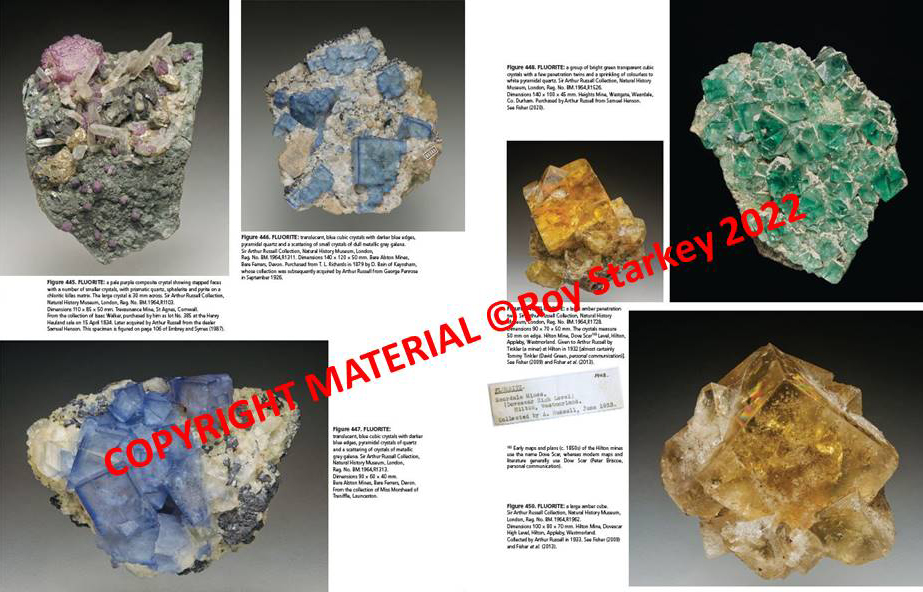
UPDATE 24 February – please note that the subscriber offer is now closed. Thank you to the 180 people who signed-up.
UPDATE 11 March 2022
The wait is almost over!
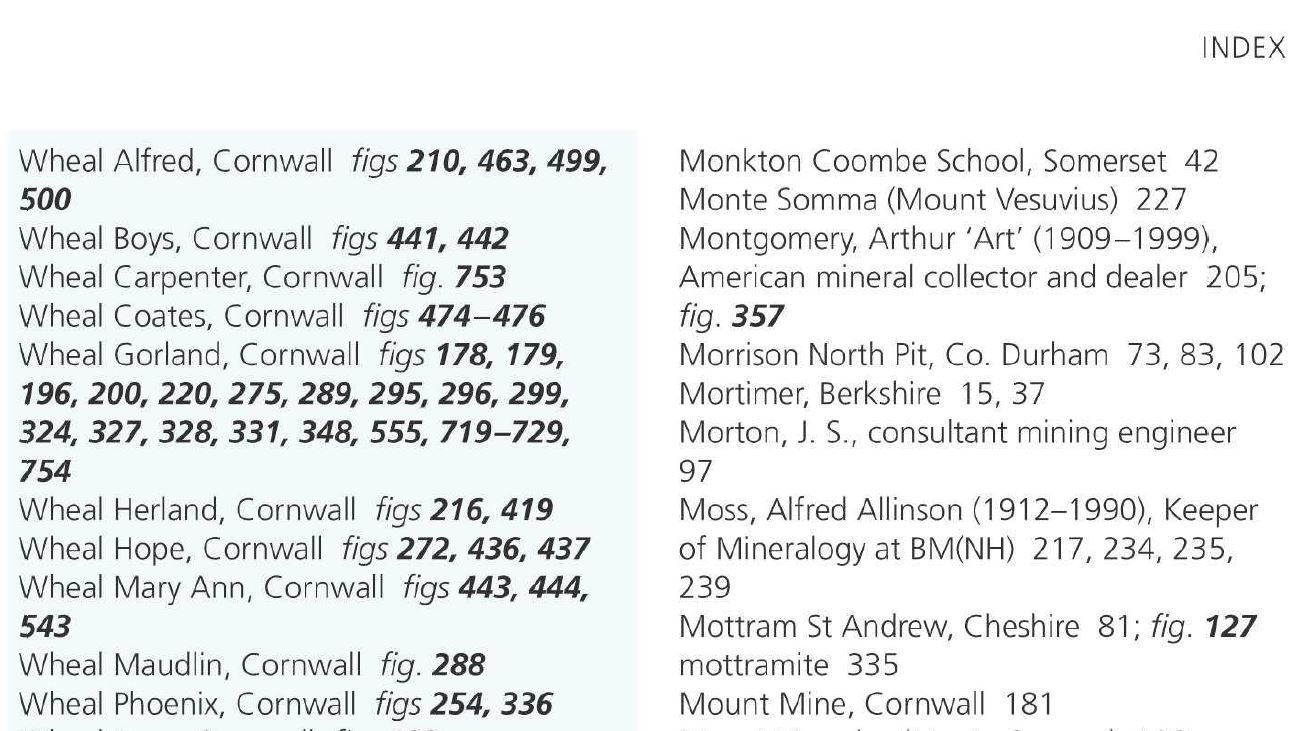
The index has now been completed (2 weeks of hell) – see photo above for a sneak peek! The blue shaded area is a portion of the mineral photo listing by locality section which I hope collectors will find a useful resource.
The final PDF of Making it Mine – Sir Arthur Russell and his Mineral Collection has now gone to the printer and the anxious wait starts 🙂 !
UPDATE 4 April 2022
The ‘running sheets’ (actual printed pages folded prior to binding) have arrived. The colour reproduction is excellent – big relief!
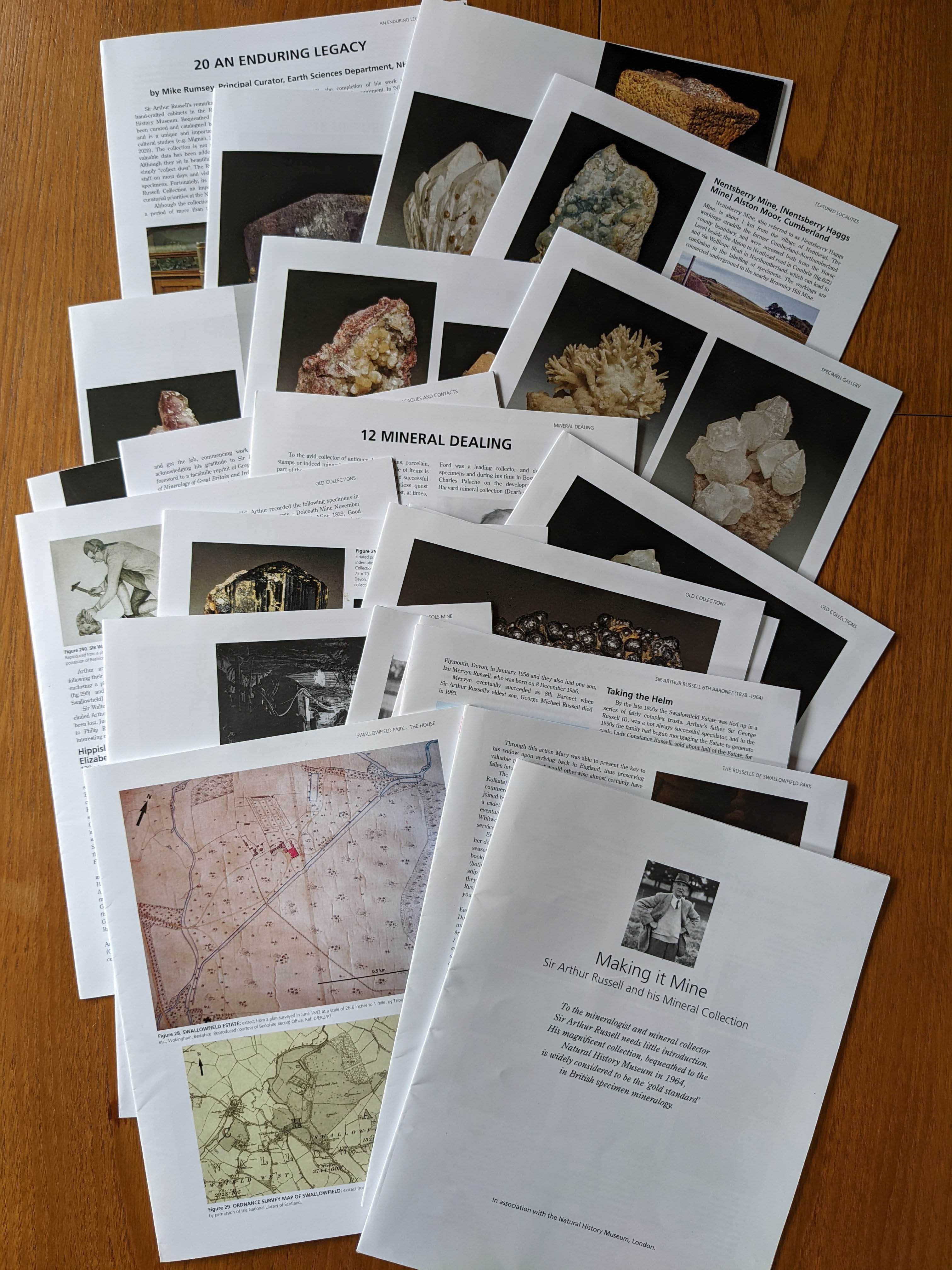
Final proofs of the cover should be delivered this week – see below for the cover design:-
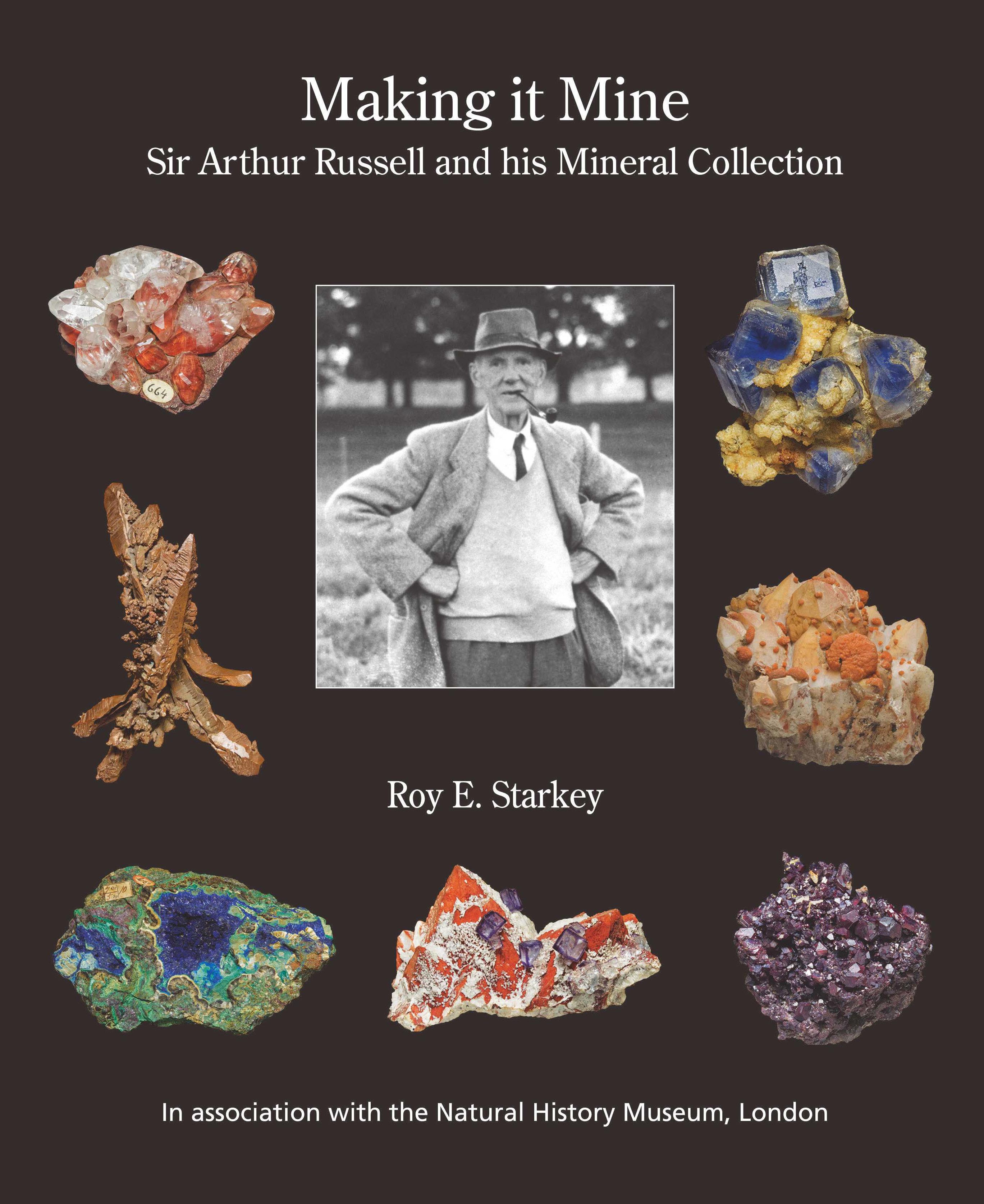
and the rear cover:-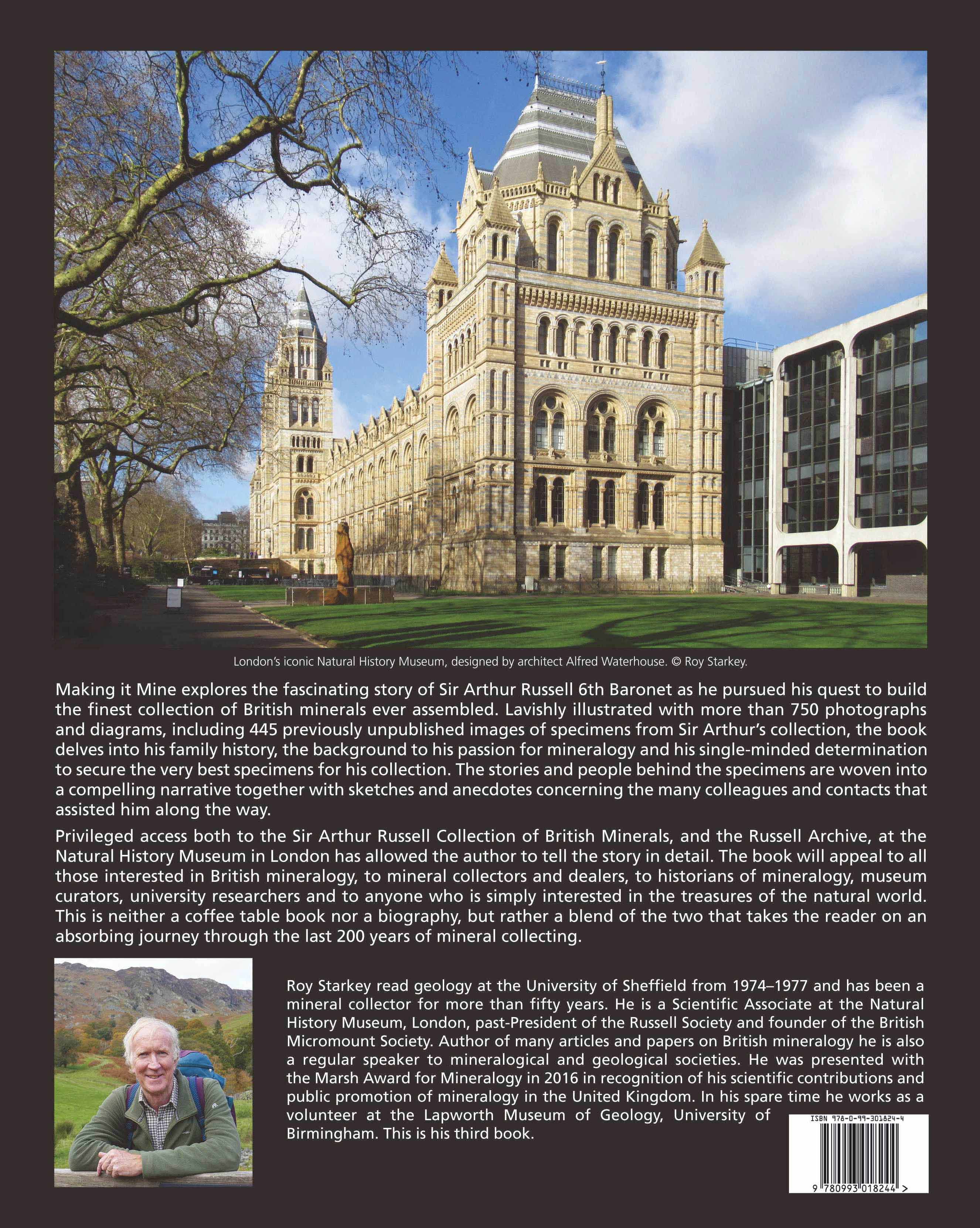
So, if all goes smoothly I am expecting delivery of the finished books by the end of the month and a formal launch at the Oxford Mineral Show on 8 May.
UPDATE 20 April 2022
Due to various production problems, and high levels of workforce absence as a result of Covid-19, the expected delivery date for the books to arrive from the printer has unfortunately slipped. The latest promise is for delivery on 4 May but I am hoping to secure a partial delivery, or if necessary to go and collect a couple of hundred copies ahead of that date to ensure that I have adequate stocks for the launch at the Oxford Mineral Show on Sunday 8 May.
If you are an advance subscriber I will be getting in touch shortly to notify you of the shipping cost or distribution arrangements as appropriate and to ask you to pay for the shipping. This will enable me to despatch your book as soon as stock is available. Please note that this is a pretty sizeable task for me to carefully pack, book shipping for, and despatch 200 or so copies and it will probably take me a couple of weeks to work through the advance orders. I will email you individually as I despatch the books.
Many thanks for your support and for your patience – not long to go now.
UPDATE 2 May 2022
Finally the wait is over – Making it Mine Sir Arthur Russell and his Mineral Collection exists!
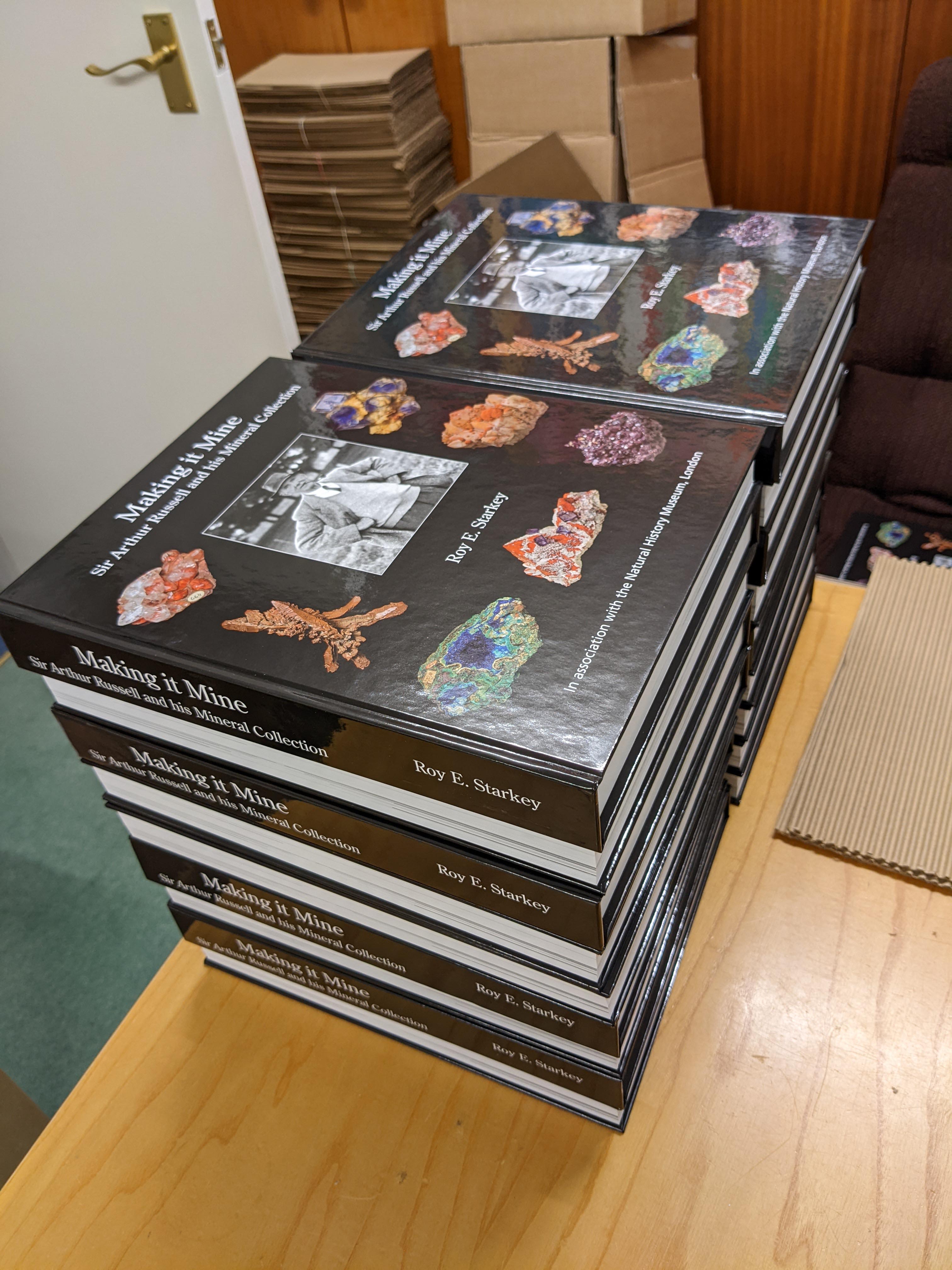
Come along to the Oxford Mineral Show for the global launch and pick up a copy this coming Sunday (8 May).
I think the book looks great and look forward to distributing copies to the many people who supported the project as advance subscribers – thank you so much!
There will be plenty of copies to go round at the Show and if you would like yours signed please just ask.
See you there!
Book launch at the Oxford Mineral Show – 8 May 2022
I am just back from a an excellent day at the Oxford Mineral Show – the sun shone, collectors turned-up in greater than usual numbers and the catering and company were great. Thank you to all the organisers!
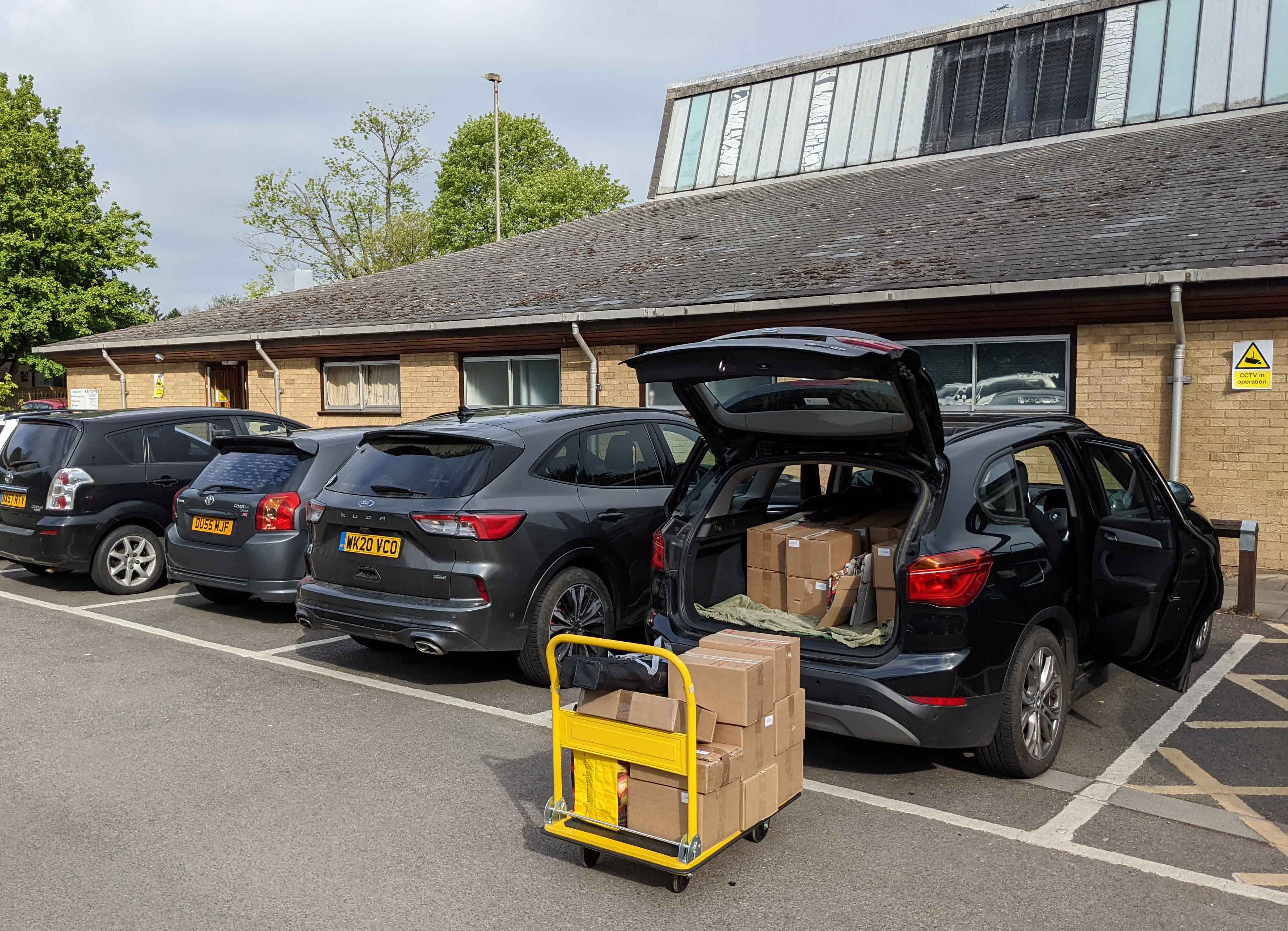
Unloading a very full car – those boxes are heavy!
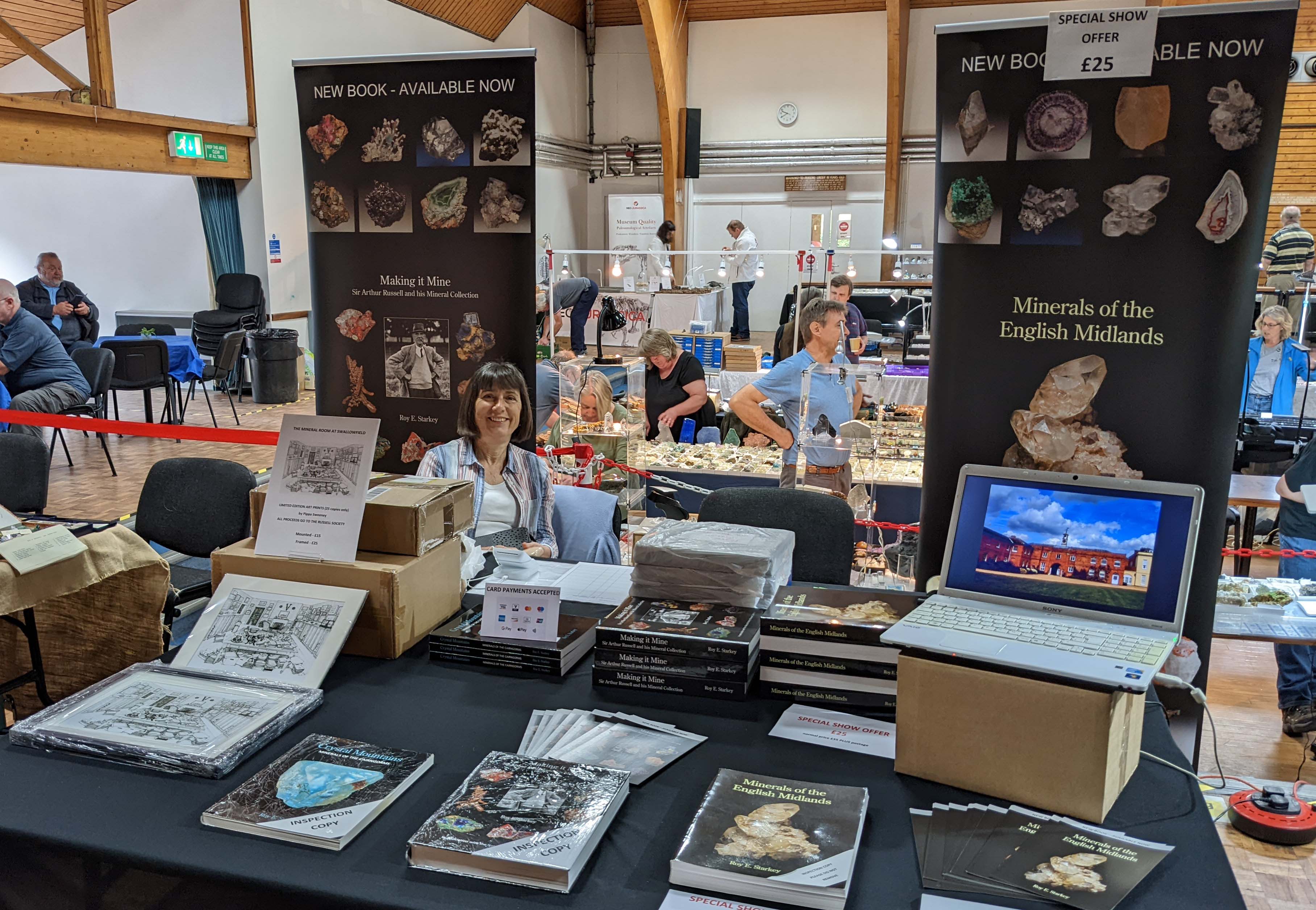
Mary ready to welcome the first customers – the first, last and only time that all three books by British Mineralogy Publications have been offered for sale. Crystal Mountains is now out of print.
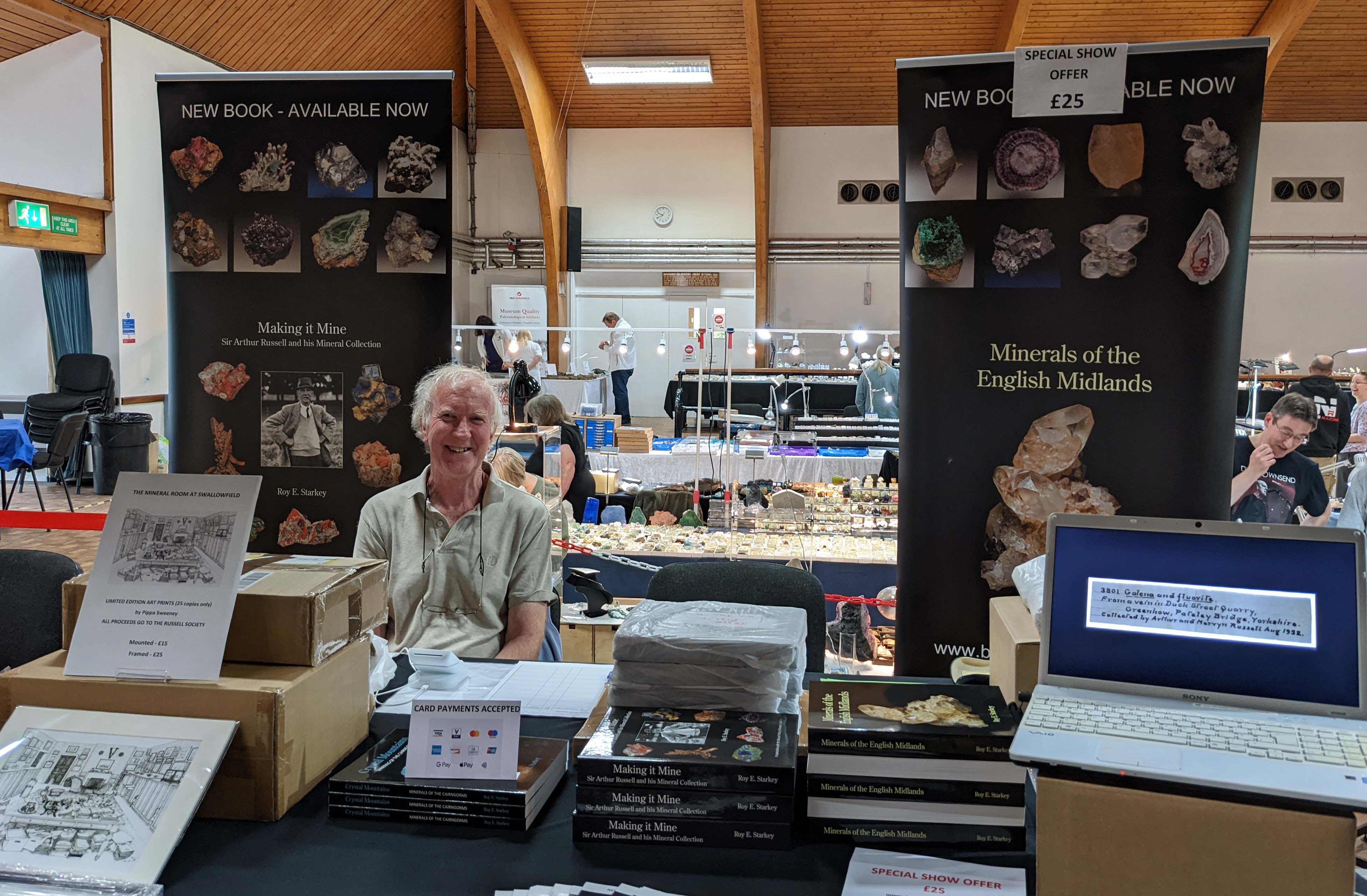
Roy waiting expectantly for the doors to open …
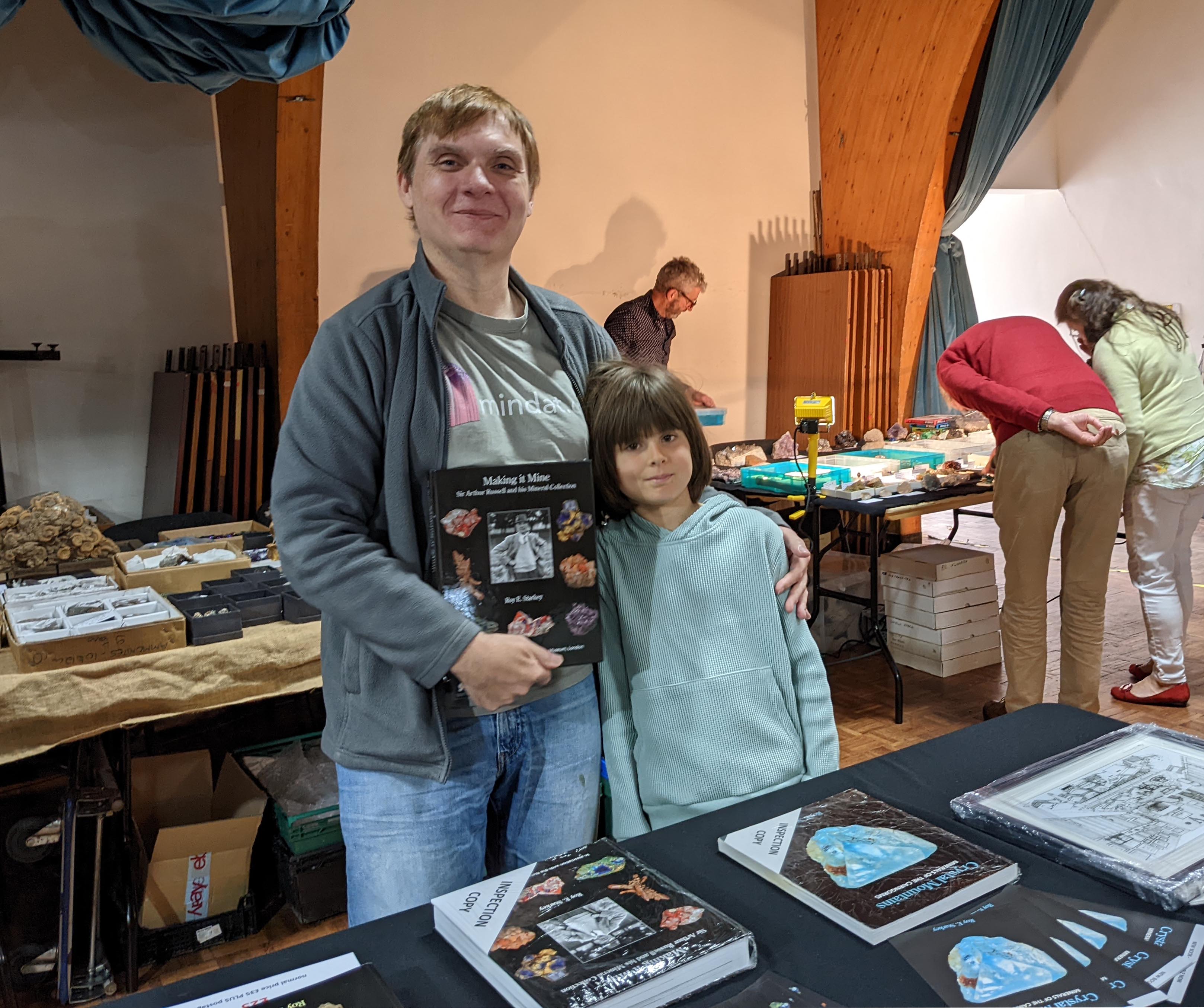
An early visitor was Jolyon Ralph, founder of Mindat.org and his son Roman. Jolyon has kindly offered to post a review of the book on Mindat so keep an eye out for his assessment.
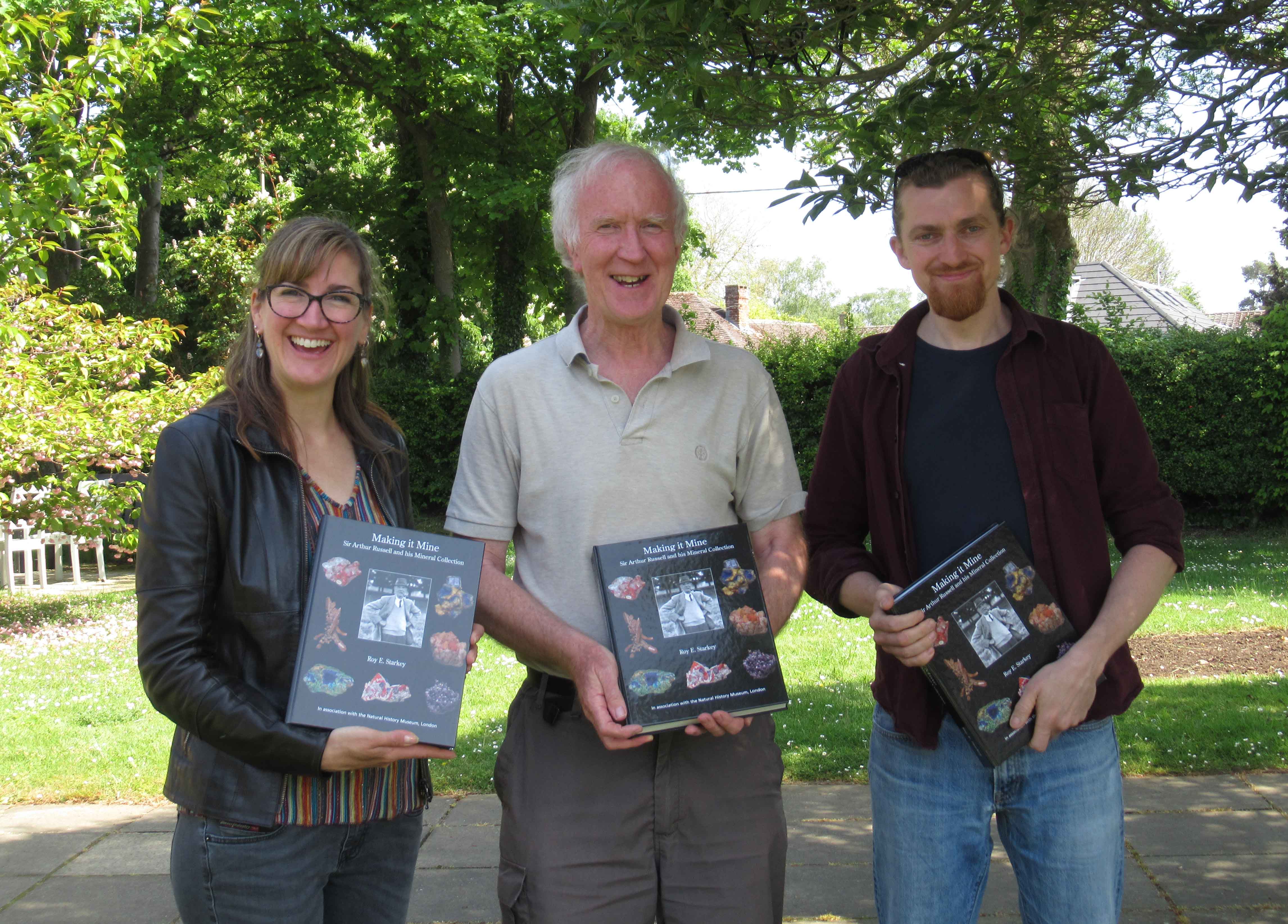
Robin Hansen and Mike Rumsey of the Natural History Museum, London also managed to call-in at the show and we took the opportunity to grab a team photo – thanks Robin and Mike!
Now the hard work begins – trying to find homes for all the books – you can now order a copy via the book orders page here
Meet the author!
You can watch an interview showing me in discussion with Bryan Swoboda of Blue Cap Productions here
